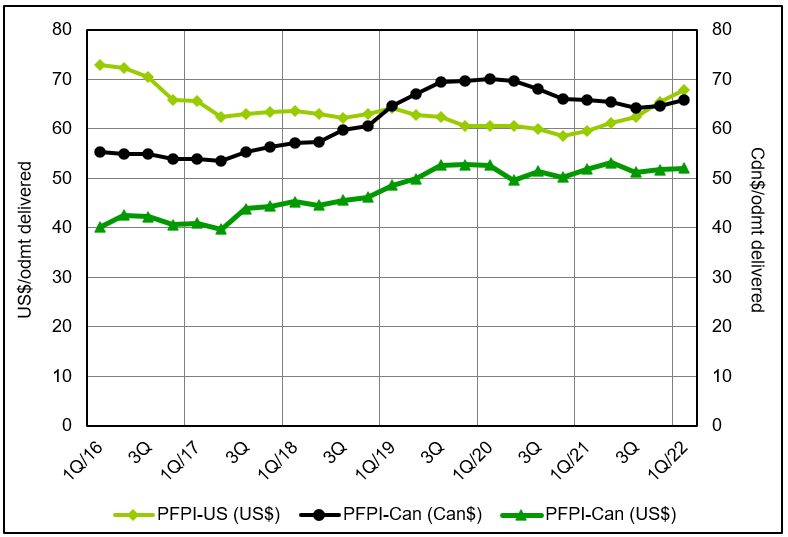This excerpt from the Q1 2022 issue of the Forisk Wood Fiber Review highlights our pellet feedstock price indices. Trends in this quarter’s pellet feedstock prices track North American fiber prices generally: prices are up. For a more detailed, regional discussion of fiber price trends, subscribe to the Forisk Wood Fiber Review.
The Forisk Wood Fiber Review pellet feedstock price indices for Canada and the US (PFPI-US and PFPI-CA), launched in 2013, show a quarterly volume-weighted price for the fiber consumed by each country’s pellet sector. The feedstock mix (roundwood, sawdust, shavings, microchips, and biomass), production capacity, and operating rates are gathered to calculate the regional price index. The price indices include the cost of chipping the roundwood and the hammering but not the drying costs.
The U.S. Pellet Feedstock Price Index (PFPI-US) increased 4% in Q1 2022, to $67.8/odmt. Feedstock prices in the South rose for all categories of fiber, driven by the rise of fuel and transportation costs. Mills continued to consume cheaper sawmill residuals, particularly in the South Central region where four new sawmills are on-line or expected to come on-line at some point in 2022.

The Canadian Pellet Feedstock Price Index (PFPI-Can) increased 2%, to Can $65.9/odmt. The U.S. dollar rose against the Canadian dollar, causing the Index to rise 1% in U.S. dollar terms. Western Canadian fiber prices increased for a fourth consecutive quarter, pressuring the favorable prices enjoyed by export pellet producers. It is still too early to entirely understand the old growth deferral in BC. Leading BC-based forestry companies continue to curtail their BC capacity and diversify their portfolio outside the province, preparing for the impact of the decision. The mid-November BC floods continue to affect supply chains, with major arterial highways and rail lines still out of service. Eastern Canada pellet producers faced favorable residual fiber prices throughout the quarter.
Click here to learn about the Forisk Wood Fiber Review (FWFR), which has tracked pulpwood, wood chip, and biomass markets in the U.S. and Canada since 1983.

Leave a Reply